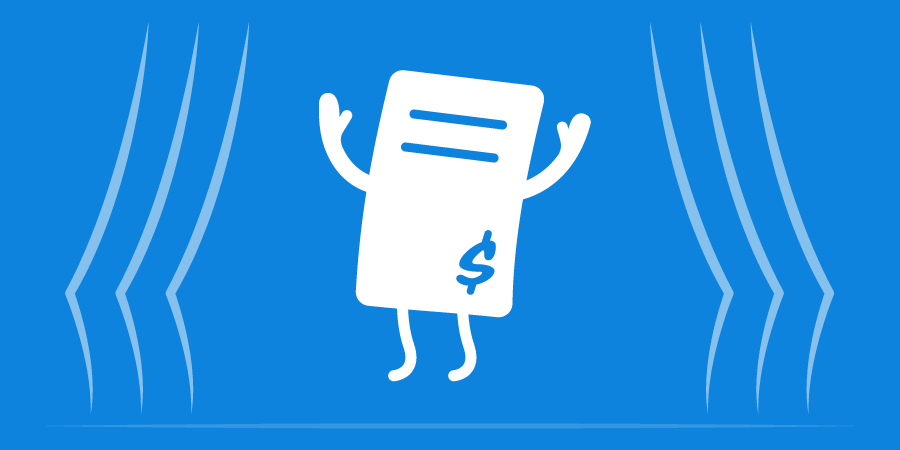
Earlier in the Billing Like a Boss series we covered how to talk about money in a way that isn’t as awkward as that time you realized (mid-conversation) that you didn’t know the name of the person you were talking to.
Now we’ll dive a little deeper into the world of invoicing. You’ll learn how to not embarrass yourself if you’re a billing beginner, the bare minimum if you want to be taken seriously, and a few easy ways to leverage your invoicing to become the biggest boss on the block.
Buckle up.
The Man Behind the Curtain

Remember how scary the Wizard of Oz was before before the curtain was drawn and we all discovered he was just an adorable senior citizen? That’s kinda what you want your invoices to do for you. (Go with me on this.) Even if you’re just a lone solopreneur working out of your parent’s basement in your housecoat and slippers, that doesn’t mean you can’t present a polished, professional curtain that portrays you as the boss you are.
Just like the way you bill (hourly, flat, value-based) makes its own statement, the appearance of your invoices will also speak on your behalf.
How to NOT Embarrass Yourself
Some of this stuff is going to feel obvious, but there are so many levels of invoicing prowess out there that I just wouldn’t feel right not including it. So here we go…
- Know whom you’re invoicing and how many times you’ve sent your invoice. This is easier to mess up than you might think. Especially if you don’t have a system for your invoicing. Do whatever you need to do to state on your invoice whom the invoice recipient is (sometimes your client, sometimes someone at your client’s financial department) and when your invoice was sent to them.
- Include the basic information such as a date and a description of what you’re billing for. This helps remind your clients when and why they are forking out money, and also covers your assets later in the case of late payment or confusion over what the invoice was for.
- Proofread your invoices. Make sure you’ve got the right person, the right date, the right dollar amount—the right everything. Again, it sounds simple, but it’s the simplest of things that slip through the cracks. So do your future-self a favor and start looking over your invoices for embarrassing mistakes that detract from your boss-like persona.
The Billing Bare Minimum
Once you get into the habit of including the basic information in your invoices, take things up another notch by including:
- Clear payment terms that cover when and how you want to be paid
- Your contact info
- Your client’s contact info
- A numbering system for easy reference for both you and your clients

Lastly, and don’t get mad, but your design software just isn’t good enough for making your invoices. Yes, it absolutely makes invoices look better than a simple spreadsheet or text-based document, no question, but what it doesn’t have is a way to help you stay on top of when you sent your invoice, if your invoice has been paid or not, how long your client took to pay the last invoice, your total income for the month—see where I’m going with this?
There are tons of tools out there to help you achieve both beautiful online billing AND total knowledge of your freelance finances. Best of all, they all provide the perk of keeping everything in one place for easy reference (insert shameless FreshBooks plug).
Taking it up a (professional) notch
Here are some surprisingly simple ways to become even more boss-like in your billing:
Say “Thank you for your business”. Why? It adds a dash of positivity, which never hurts the speed of your payment, and adds a dash of professionalism to the relationship.
Accept online payment from your clients. Another thing you can do to make your client’s life easier (and thus keep them longer and maybe even get more) is to make the payment process as easy as possible. So when you send your invoice (promptly) after finishing a project, let your clients pay their invoice from the comfort of their home/office by accepting online payment. Yes, there will be a transaction fee, but think of it this way. You’re making the payment process so convenient for your client that you could likely increase your rates a touch for being so delightful to work with (just like the price difference between economy and business class on a flight).
Request advance payment (aka Deposits). Ok, here’s one that’s less about your client’s happiness and more about your own well being. Before you begin working on a project (especially a big one) request a deposit.
If you already do this—fantastic!
If you don’t request deposits, that’s totally OK. Many industries don’t need to because they have a physical item they can withhold in lieu of payment.
But this is not the case for us (I’m speaking specifically about web designers).
If we put in the work and the client skips town (proverbially), you are left with nothing. You’ll never get that time back, you could have been making money working on something else, and the final product you have is rarely resellable.
Before you say “Woah now! That’s too much to ask”, think of framing deposits this way. By requesting deposits, neither you nor your client ever has to take on 100% of the financial risk. At the beginning, your client has to trust that you’ll put in the work. At the end, you have to trust that your client will come through with payment. Make your case on the platform of mutual trust because we all know the world of commerce can sometimes be far from fair.
Follow up with clients. Give a quick check in to see how they are enjoying your product/service after the project is completed. Nothing extensive, just a quick check in. Your clients will be appreciative that you’ve taken the time to show you care and will form an even stronger, more positive association with you, thus making it easier to remember you the next time they need something.
Now onto what you get out of client follow up (other than warm fuzzies, of course).
By checking in with your clients to see how things are going post-payment, you’re secretly doing research for areas of improvement in your own work/process. I’m not saying you should give clients a full survey (although that would be smart), it can be as simple as a how’s everything going? email. You’re not committing to extending the contract (although that would be the smartest) or doing more work for free. You’re simply looking to ensure things are up to standard and there are no areas of improvement that are completely off your radar.
Curtain Call
So there you have it. The inner workings of an invoice that fully lives up to its higher purpose of creating a curtain of professionalism that says to the world “I’m a total boss at what I do”.
Just as you would put thought into what your website says about you (be it with words or not), you absolutely want to take time to consider the impression your invoices give off.
Why?
Because your invoice is the predecessor to your paycheck.
Next, we’ll leap even further into Billing Bossdom with a few crafty hacks to get your invoices paid lightning fast!






Additional suggestion here is “make sure you include the purchase order number” your invoice relates to.
Contracts are one thing, but in a lot of companies it’s the purchase order that they use to reference whether the invoice is a legitimate one.
This is an exceptionally good article and very much on point for a great many web designers and other freelancers. Thank you for sharing.
Great post with great advice. Thanks Jaclyn!